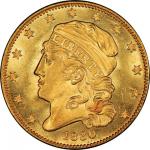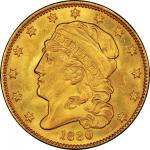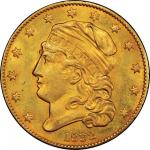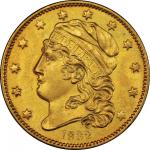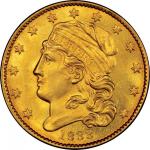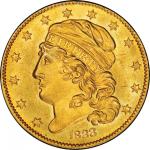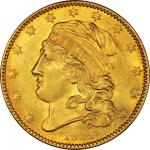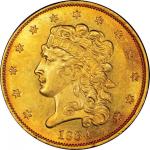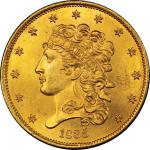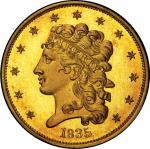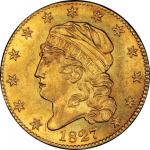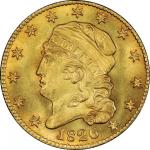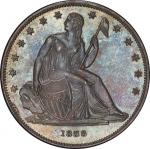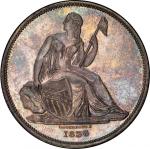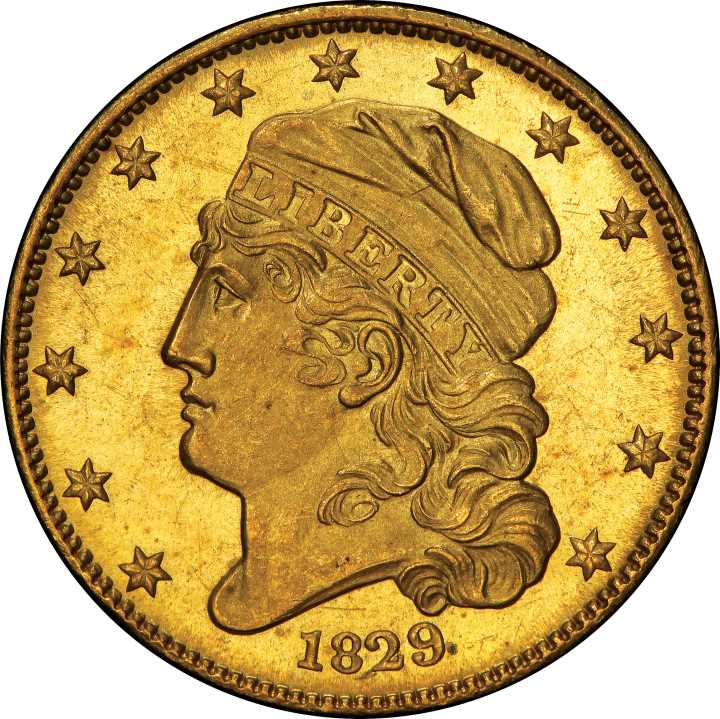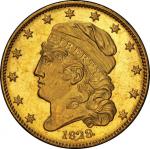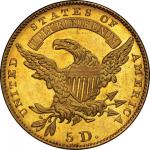1829年美国自由帽版5美元 PCGS MS 65。1829 Capped Head Left Half Eagle. Reduced Diameter. Bass Dannreuther-2. Rarity-7. PCGS MS 65.I must have seen 100 pounds of gold in bars & hoops ready to be manufactured into half eagles ... but it is said they are immediately shipped to Europe bearing a handsome premium.” — Benjamin Leonard Covington Wales, upon visiting the United States Mint, December 28, 1829</em>The rarest date of this design type, the 1829 is the debut issue of the Small Planchet Capped Head half eagle, showing a refinement of the related Large Planchet design that was coined from 1813 to 1829. The D. Brent Pogue specimen shows superb deep yellow patina that swirls with satiny luster when rolled in hand and glows with reflectivity under direct light. The changes made to half eagle dies this year, including a high retaining rim around the designs, successfully improved striking detail on both sides. All design elements are bold and well defined, though the curl near Liberty’s ear and her lowest curl near star 13 show some very modest flatness in their highest relief. The eagle is fully feathered and the denticles around both sides are crisp. The talon at right, opposite the high relief fold of Liberty’s cap, does not show as much relief as the engraver and coiners perhaps would have liked; this localized issue was not resolved during the short life of this design type. The eye appeal of this coin is as satisfactory and attractive today as when it left the Mint.The surfaces show the familiar radial lines in the gold that form coronas around deeply engraved design elements and the peripheries, these imbued when the soft gold planchet was firmly squeezed between the dies. Some very light hairlines are seen under a glass, left by nothing more egregious than typical handling, and no marks are seen.
The cheek is clean and the portrait is lovely. A short horizontal scratch makes a brief appearance on the bust truncation and continues over the 8 of the date. Some light coppery overtones, evidence of originality, are seen on both sides, including spots near 18 of the date and star 12 on the obverse and some faint stripes beneath US of PLURIBUS and under the wing at right on the reverse. A minuscule lamination crosses the final date digit and a tiny jade green copper impurity, inherent in the planchet, peeks out just right of the 9, revealing the reason for the lamination and offering a rare view into the issues the Mint faced when assaying native gold. A related but unerupted lamination is noted below the space between 82. A tiny circle, left by something adhering to the die face at the moment of striking, is seen to the lower left of star 7.Above the tops of all letters in UNITED, vestiges of a first attempt at punching that word have been effaced, leaving only microscopic evidence of a placement that was apparently deemed too close to the denticles and removed. ICA of AMERICA show similar correction, an indication that the legends were punched into the die somewhat symmetrically, rather than starting at the beginning and proceeding around the circumference until complete.Elegantly produced and beautifully preserved, this coin represents a change in technology that presaged a change in venue.
In autumn 1827, a new screw press arrived at the United States Mint from the Philadelphia machining firm of Rush and Muhlenberg. Weighing nearly three tons, the press was extraordinarily powerful; researcher Craig Sholley has suggested that the new press likely served primarily as a hubbing press. Soon after the new presses’ arrival, the Mint began to modify their dies, beginning with dimes in 1828, continuing with half dimes, quarter eagles, and half eagles in 1829, and finally changing over quarters in 1831. The diameters were shrunk and the peripheral rims were raised, allowing for higher relief on the portrait and better striking detail throughout. When B.L.C. Wailes visited Philadelphia from his home in Natchez, Mississippi at Christmastime 1829, he saw coins just like this one being struck. His journal, published in <em>The Pennsylvania Magazine of History and Biography</em> in July 1954, carefully described the minting apparatus, including the usage of a collar to imbue the reeded edge device. Wailes described the two-piece close collar as “a pair of nippers (which gives the milling or impression on the edges).
His visit to the Mint on December 28, 1829 provides one of the best eyewitness accounts of the Mint’s operations during this era.I presume 60 pieces may be stamped per minute, the cutting is done equally fast. A great quantity of N. Carolina & Virginia gold is required. But it is said they are immediately shipped to Europe bearing a handsome premium. I must have seen 100 pounds of gold in bars & hoops ready to be manufactured into half eagles. I learn that the precious metals are deposited by individuals. They are then refined & assayed & the true value ascertained & the full weight is given in coins. The number of hands employed is said to be about 20, & the establishment costs the government about 40,000 dollars annually, the expense of the establishment itself not being defrayed out of the coining. Mr. Eckfeldt, one of the superintendents (the second in grade) is an artist & has been in the Mint from its first establishment.A group of half eagles was deposited with the Mint treasurer on December 31, from which four coins were reserved for assay, and a further delivery of 1829 half eagles was made on February 6, from which three coins were saved for the assay to take place on February 8, 1830. Though more than 15,000 coins were delivered on December 31, few of them entered circulation and fewer still survived for any significant length of time. When John W. Haseltine cataloged the William J. Jenks collection in 1883, he remarked on the 1829 Small Planchet half eagle, “I do not know that collectors are generally aware of its existence, as I believe that never but one has made its appearance in a sale.” This coin was acquired by Thomas Cleneay before 1887, and when the still-young Chapmans cataloged it in 1890, they recognized that the “Small date, stars, and planchet” issue was “extremely rare.” Cataloged as “Uncirculated. Proof surface,” this coin was purchased at the sale in Philadelphia by a visitor from faraway Omaha, Byron Reed.
Reed’s name appears frequently in named copies of the Cleneay catalog, but he did not get the chance to enjoy his bounty of new acquisitions long. He passed away barely six months after the Cleneay sale and left his collection to his adopted hometown, along with a plot of land upon which to build a library to house it. This coin remained in his cabinet, curated by the city of Omaha, for over a century, until sold at auction in 1996.Unlike the Large Planchet 1829 half eagles, which are all relatively high grade but one, the Small Planchet coins of this year have not all survived so fine. Two Proofs are known, both in institutional collections, the National Numismatic Collection at the Smithsonian Institution and the Harry Bass Foundation. The Smithsonian also holds the lightly circulated Lilly coin. Among the six others identified by Saul Teichman, this is far and away the finest. The Bass duplicate, earlier from the H.P. Smith and William F. Dunham collections, has been graded MS-61 (PCGS). While the PCGS Population Report lists one coin graded in MS-61, MS-62, and MS-63, Teichman’s census lists the Garrett coin as “Choice AU,” the Stickney-Brand coin as “AU,” the Fred E. Davies coin as “Choice AU,” and the Eliasberg coin as “XF cleaned.” Presumably one or both of the Garrett and Davies coins have received the MS-62 and MS-63 grades from PCGS, which has graded but four examples of this issue in all grades. No other half eagle from 1829 to 1834 approaches this one in rarity, and no other example of this issue compares to the Cleneay-Reed-Pogue coin in quality.PCGS# 8151. NGC ID: 25R9.

